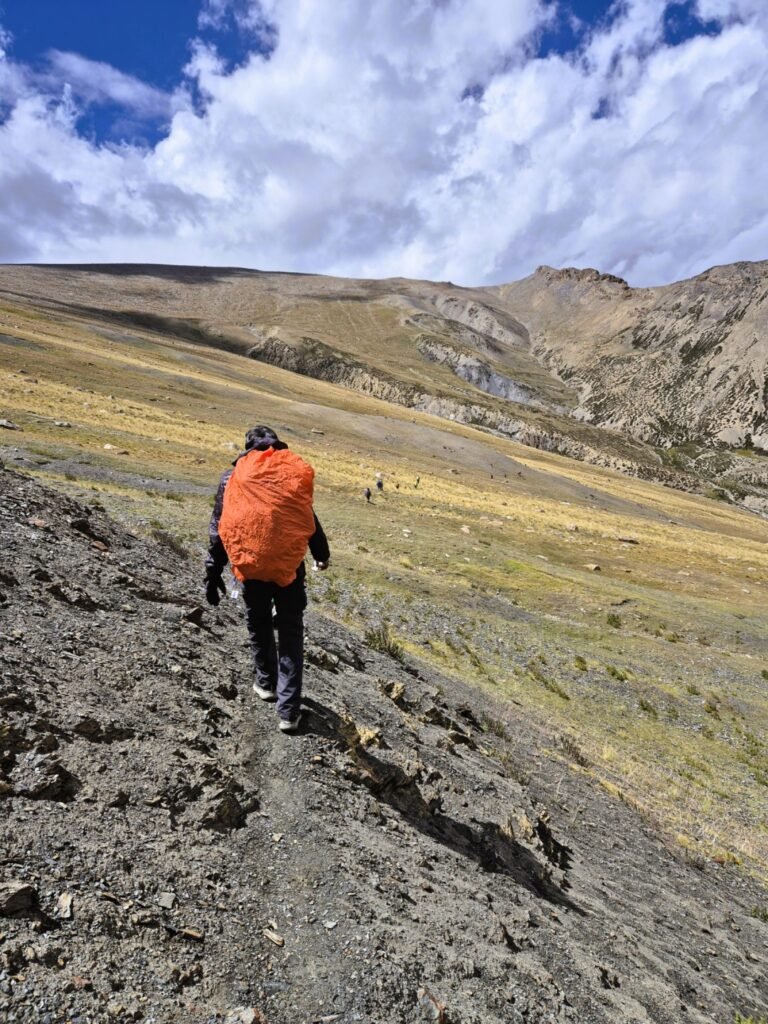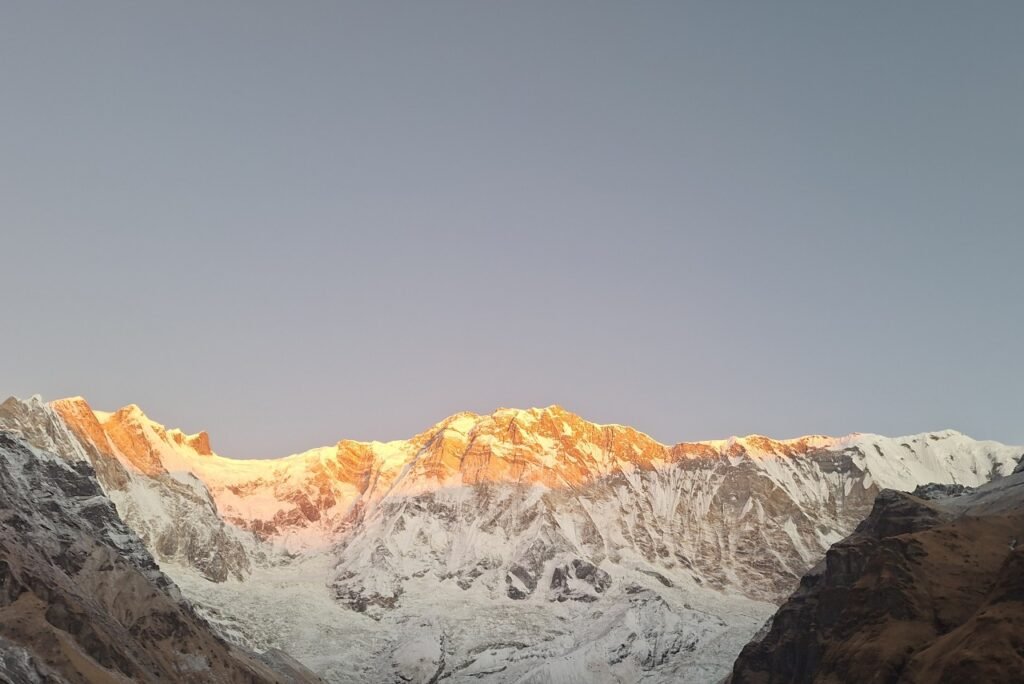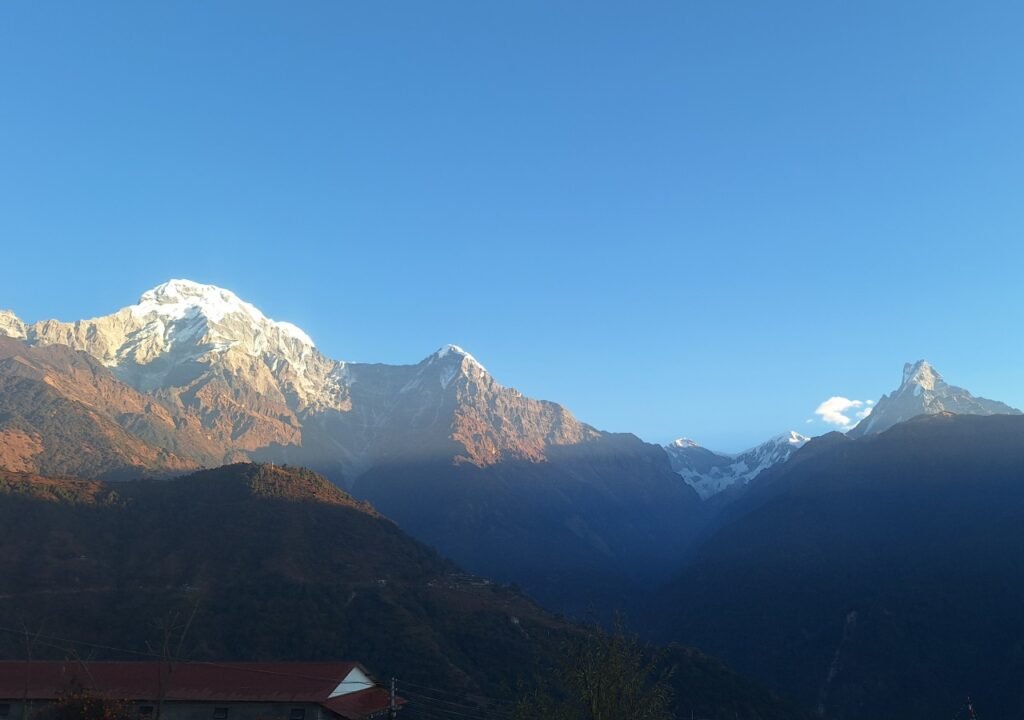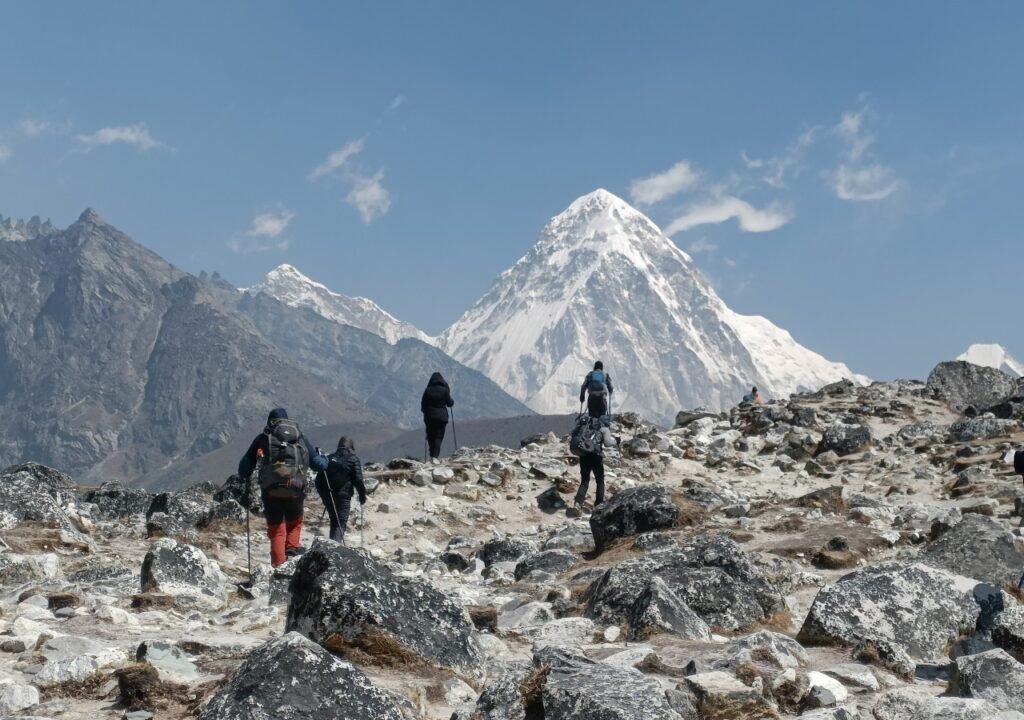Dzo Jongo East Trek
A challenge made for the bold—trek to the heights of 6,240M.
Talk to an Expert
Trek Difficulty
Challenging
Trek Duration
10 Days (Leh to Leh)
Highest Altitude
6,240 meters (20,472 ft)
Suitable For
Experienced trekkers
Accommodation
Twin/Triple sharing*
Total Trek Distance
75–80 km approx.
Basecamp
Leh
Accomm. Type
Guesthouses / Hotels / Tents
Pickup Point
Leh Airport (IXL)
Accommodation Level
Economical
Dzo Jongo East
A Summit Where Earth Meets Sky
The Dzo Jongo East Trek is a 10-day journey covering approximately 75–80 km through Ladakh’s rugged terrain.
It reaches a summit height of 6,240 meters, offering panoramic views of Kang Yatse, Markha Valley, and the Zanskar ranges.
The trek involves crossing high mountain passes like Shiul Pass, Chak Pass, and Kongmaru La, with steep ascents on snow and scree slopes.
It’s ideal for experienced trekkers, requiring technical gear like crampons and ropes for the summit push.
Trek Fee
INR 40,000 (all inclusive) / per person
Optional Add-ons
- INR 3,400 Backpack Offloading
- INR 2,300 Single Tent Accommodation
- Travel and Emergency Insurance
Available Dates to Register
- 5 July - 14 July
- 19 July - 28 July
Additional Information
Inclusions & Exclusions
Inclusions
- Comfortable accommodation in Leh
- Nutritious vegetarian meals during the trek
- Technical climbing gear: ropes, helmets, crampons, ice axes, boots.
- High-quality camping equipment: tents, sub-zero sleeping bags, mats.
- Certified expedition leader and skilled local mountain guides.
- Private transport for Leh to trek start point and back.
- Safety measures: first aid kit, portable oxygen cylinders, stretcher.
- Gaiters, crampons, microspikes provided as per terrain conditions.
Exlusions
- Meals in Leh (Day 1, Day 2, Day 9) are not included.
- Meals during road transfers are excluded.
- Personal expenses like snacks, drinks, tips, etc.
- Travel/trek insurance is not included but recommended.
- Porter/mule services are excluded but can be arranged.
- Permits and fees to be paid in cash (Inner Line Permit, IMF Fee).
- Buffer day costs (Day 10) will be extra if used.
- Extra services/items not listed in inclusions are chargeable.
What Makes Dzo Jongo East a Must-Do Trek
A Hidden Gem in Ladakh
Dzo Jongo East is one of Ladakh’s lesser-known peaks, adding a sense of mystery and intrigue to your trekking experience. Starting from Leh, the peak remains hidden for much of the journey, revealing itself only when you reach the base camp. This unique characteristic of the trek keeps the anticipation alive throughout the trail.
An Offbeat Alternative to Popular Peaks
While Kang Yatse and Stok Kangri attract large crowds, Dzo Jongo East offers a quieter and more peaceful experience. For trekkers seeking a less-commercialized route, this trek allows a deep connection with Ladakh’s pristine landscapes and solitude in nature.
A Challenging Ascent That’s Rewarding
The climb to the summit of Dzo Jongo East at 6,240 meters is steep and demanding, requiring the use of technical gear like crampons and ropes. Though not highly technical, this trek is perfect for experienced trekkers looking for an adventure that tests their endurance and skills.
Unparalleled 360° Himalayan Views from the Summit
At 6,240 meters, the summit rewards trekkers with panoramic, 360-degree views of Ladakh’s stunning landscapes. You’ll see Kang Yatse Peaks, the sprawling Markha Valley, Stok Kangri, the distant Zanskar ranges, and even the mighty Karakoram Range. The uninterrupted scenery from the top truly captures the grandeur of Ladakh’s rugged terrain.
Diverse Terrain Along the Route
The trek includes a mix of terrains—gentle alpine meadows, rocky paths, river crossings, and glaciated sections. Along the way, you’ll traverse three high-altitude passes: Shiul Pass, Chak Pass, and Kongmaru La, each offering its own unique challenges and perspectives.
Preparation for Higher Peaks
Dzo Jongo East is an excellent choice for trekkers aiming to conquer tougher 7000m+ peaks. It combines high-altitude trekking with semi-technical challenges, helping you build confidence and experience for future climbs.
A Trek with Variety at Every Step
From the river crossings of Shiul Sumdo to the dramatic ascent to Chak Pass, the Dzo Jongo East Trek engages you with something new each day. The carefully chosen route from Lato ensures you experience both adventure and Ladakh’s natural beauty.

Dzo Jongo East Trek – 10-Day Detailed Itinerary
Day 1: Arrival in Leh (3,500M)
- Arrive in Leh, the gateway to Ladakh, at an altitude of 3,500 meters.
- Take it easy today — your body needs time to adjust to the high altitude.
- Explore the local markets, visit Leh Palace or Shanti Stupa if you're feeling up for a gentle walk.
- Drink plenty of fluids and get good rest.
Day 2: Acclimatization Day in Leh (3,500M)
- To help your body adapt, take a short hike to nearby attractions like the Shanti Stupa or Namgyal Tsemo Monastery.
- Avoid strenuous activity but try to stay active.
- Hydration and light walking will help you prepare for the higher altitudes ahead.
Day 3: Drive from Leh (3,500M) to Lato (4,014M)
- Leave Leh after breakfast and drive to Lato, a scenic village located along the Indus River at 4,014 meters.
- The drive takes around 2–3 hours.
- Settle into your camp and enjoy the changing landscape.
- This is your first night at a higher altitude, so continue to take it slow.
Day 4: Trek from Lato (4,014M) to Shiul Sumdo (4,600M)
- Your trek begins! Walk alongside dramatic rock formations and gentle streams as you make your way to Shiul Sumdo, a beautiful campsite at the confluence of mountain valleys.
- The altitude gain is gradual but noticeable.
- Trek duration: 5–6 hours.
Day 5: Shiul Sumdo (4,600M) to Chaksung (4,900M) via Shiul Pass (5,100M)
- Climb to Shiul Pass (5,100M), enjoying panoramic mountain views.
- Descend through rugged trails to Chaksung (4,900M).
- Trek duration: 6–7 hours, the terrain becomes more rugged and alpine.
Day 6: Chaksung (4,900M) to Dzo Jongo Base Camp (5,200M) via Chak Pass (5,500M)
- Steady climb to Chak Pass (5,500M), offering incredible peak views.
- Gradual descent to reach Dzo Jongo East Base Camp (5,200M).
- Trek duration: 6–7 hours; prepare for high-altitude camp life.
Day 7: Rest and Acclimatization at Base Camp (5,200M)
- Rest at base camp to recover and acclimatize before the summit push.
- Participate in snow skills practice or take light exploratory hikes.
- Check technical climbing gear and review summit plans.
Day 8: Summit Day – Dzo Jongo East (6,240M) and return to Base Camp (5,200M)
- Begin the summit push before dawn, navigating steep snow and glacier sections.
- Reach the summit (6,240M) for stunning 360° views of the Himalayas.
- Descend back to base camp, the round trip takes 10–12 hours.
Day 9: Base Camp (5,200M) to Leh (3,500M) via Kongmaru La Pass (5,236M)
- Cross Kongmaru La Pass (5,236M) with breathtaking views of the Zanskar range.
- Descend through scenic gorges to Chokdo or Shang Sumdo.
- Drive back to Leh for a relaxing evening.
Day 10: Departure from Leh
- Depart Leh, completing the unforgettable Dzo Jongo East Trek.
- Take with you cherished memories of breathtaking vistas and alpine adventures.
Facts and Important Information
Leh is the gateway to Kang Yatse II and all major treks in Ladakh.
By Air (Most Convenient & Popular)
- Kushok Bakula Rimpochee Airport (Leh – IXL) is well connected to:
- Delhi (daily direct flights)
- Mumbai, Chandigarh, Srinagar, Jammu (seasonal)
- Delhi (daily direct flights)
- Carriers: IndiGo, Vistara, Air India, GoFirst
Note: Flights arrive early in the morning. The landing is scenic but bumpy—be prepared for thin air as soon as you land.
1: Government-Issued ID
- Aadhar Card, Passport, Driver’s License, or Voter ID
- Carry original and 2–3 photocopies
- Used for registration at checkposts, permits, and in case of emergency
2: ILP (Inner Line Permit)
- Mandatory for all Indian and foreign nationals in Ladakh
- Can be arranged by Captain Alpine If Help needed
- Needed for passing through protected areas like the Markha Valley
3: Medical Certificate (Fitness Declaration)
- Issued by a registered medical practitioner
- Should mention that you’re fit for high-altitude trekking up to 6,250M
- Senior citizens or those with pre-existing conditions may need additional clearance
- Captain Alpine will provide a standard format for this
4: Disclaimer/Indemnity Form
- Signed declaration acknowledging risks involved in high-altitude trekking
- Provided by your Captain alpine adventures
- Must be signed before the trek starts
5: Passport & Visa (for Foreign Nationals)
- Carry your original passport and valid Indian visa
- 2–3 copies needed for permits and checkposts
- Some areas may require additional clearance (e.g., Protected Area Permit [PAP] for foreign nationals)
Expedition Leader and Guide
- Certified & experienced in high-altitude trekking
- Leads the group, sets the pace, monitors health and morale
- Trained in first aid, AMS response, and emergency evacuation protocols
- Acts as the main decision-maker in case of weather delays, health issues, or route changes
Kitchen Staff / Cook
- Prepares nutritious and hot meals at each campsite
- Follows strict hygiene standards
- Adapts meals based on altitude conditions and energy needs
- Can accommodate basic dietary restrictions with prior notice
Support Staff (Helpers & Camp Managers)
- Set up tents, dining area, and sleeping arrangements
- Help with water, logistics, and campsite cleanliness
- Assist trekkers with backpacks, especially during river crossings or steep sections (on request)
Mule/Porter Team
- Carries camping equipment, common gear, kitchen supplies
- You carry only a daypack with essentials (camera, water, snacks, rain gear)
- Personal backpacks can be offloaded (optional, pre-booking required)
You Are in Good Hands
- Our team is local, friendly, and deeply familiar with the terrain
- They’re passionate about the mountains—and your experience
- Your safety and well-being are their top priority
Pre-Trek Health Requirements
- Medical Fitness: Ensure you consult your doctor and confirm that you are medically fit for high-altitude trekking, especially up to an altitude of ~20,505 ft.
- Mandatory Vital Checks for Certificate: Blood pressure, heart rate, and general stamina levels must be assessed for obtaining a medical certificate.
- Acclimatization Readiness: Particularly important if you have experienced altitude-related issues before. Early preparation helps manage high-altitude adjustments better.
Physical Fitness Preparation
- Cardio Training: Engage in brisk walking, jogging, cycling, or swimming at least 4–5 days per week for 4–6 weeks leading up to the trek.
- Strength and Endurance Training: Focus on exercises like squats, lunges, and planks to strengthen your core and legs.
- Practice Treks: Undertake day hikes with a backpack to simulate trekking conditions and get accustomed to carrying essential gear.
Altitude Awareness
- The trek ascends to altitudes up to 20,505 ft, where oxygen levels are low.
- Symptoms of Altitude Sickness to Watch For:
- Headache.
- Nausea.
- Dizziness.
- Loss of appetite.
- Fatigue.
- Action Steps: Inform your expedition leader immediately if you experience any symptoms. Early intervention is critical.
Essential Personal Medication
- Bring your personal prescription medicines.
- Include a basic first-aid kit with items like paracetamol, antiseptic cream, ORS, pain relief spray, and band-aids.
- Important Note: Always inform your trek leader before taking any medication during the trek.
Health and Safety Guidelines
- Avoid alcohol, smoking, or sedatives during the trek as they can impact acclimatization and overall health.
- Stay hydrated by drinking water regularly, even when you don’t feel thirsty.
- Maintain personal hygiene at campsites to prevent infections.
- Listen to your body and report any discomfort immediately to your group leader or guide.
Emergency Protocol
- Expedition leaders carry a basic medical kit and are trained in wilderness first aid.
- In case of severe illness or injury, evacuation support is available.
- A buffer day is included in the itinerary for recovery or delays due to health or weather-related challenges.
Trekking to an altitude of 6,240M is possible at any age with intentional preparation and respect for the mountain.
1: Mindset and Preparedness:
- Understand that the trek involves semi-technical climbs, cold glacier sections, and long summit hours of 10–12 hours.
- Seniors should be in excellent cardiovascular health and comfortable walking 8–10 km daily with elevation gain.
- Be aware of altitude risks and mentally prepared for the challenging conditions.
2. Mandatory Medical Clearance:
- Consult your doctor with a detailed itinerary and altitude profile.
- Opt for cardiac stress and lung function tests if necessary.
- For conditions like hypertension or diabetes, discuss medication adjustments with your physician.
3: Physical Preparation Plan (3–6 Months):
- Walking and Hiking: Build up to 10–12 km daily walks with inclines, 3–5 times a week.
- Strength Training: Focus on legs, hips, and core to improve stamina and balance.
- Breathwork and Stair Training: Practice controlled breathing exercises to improve oxygen efficiency and incorporate stair climbing with light weights.
4: Acclimatization Tips:
- Spend at least 3–4 days in Leh (3,500M) prior to the trek for acclimatization.
- Stick to a slow and flexible itinerary to ease into higher altitudes.
- Avoid heavy meals, alcohol, and caffeine during the initial acclimatization period.
5: Essential Medications and Monitoring:
- Carry required medications, such as those for blood pressure or insulin, and monitor vitals with an oximeter. Oxygen saturation levels should ideally remain above 80% at high camps.
Trekking to Dzo Jongo East is not recommended for individuals below the age of 17, as the physical and mental demands of the trek are significant.
Dzo Jongo East Trek Trivia
The Summit is a Closely Guarded Secret
For most of the journey, the summit of Dzo Jongo East remains hidden. Trekkers can only get their first real glimpse of the peak upon reaching the base camp, making its reveal a unique and thrilling moment.
A Night Sky Like No Other
Due to minimal light pollution, the campsites along this trek offer some of the clearest views of the Milky Way galaxy. Stargazing here becomes an unforgettable experience that feels like a window to the universe.
The Rare Ladakhi Blue Sheep Encounter
Trekkers often spot a glimpse of the shy and elusive blue sheep (Bharal) along the trail. These mountain-dwelling creatures blend seamlessly with the rugged terrain, making sightings a rare treat.
The Forgotten Pass of Shiul
Shiul Pass is one of the less-discussed high-altitude passes on this trek but features breathtaking views of the surrounding valleys. It stands out for its peaceful solitude compared to the more popular Kongmaru La.
Latest Reviews
” Aenean sollicitudin, quis auctor, nisi elit consequat ipsum, nec sagittis sem nibh id elit. Duis sed odio. “
Lauren Munoz
Ronald Snyder
Jessica Hawkins
Sean West
Challenge Yourself, Conquer the Summit
Start your journey to the summit of Dzo Jongo East at 6,240 meters. Limited slots available—secure your spot now!
Latest Blogs
Dzo Jongo vs Stok Kangri vs Kang Yatse: Which Himalayan Peak Should You Choose?
Dzo Jongo East Trek: The Hidden 6000er of Ladakh Few Know About
Is Dzo Jongo East Trek Right for You? Skill, Fitness & Acclimatization Guide
F.A.Q.
Dzo Jongo East Trek is a challenging high-altitude trek that requires prior experience in trekking at elevations above 5,000 meters. The ascent to the summit involves steep slopes, scree terrain, and snow, making it suitable for seasoned trekkers who are comfortable with technical gear like crampons and ropes.
The trek lasts 10 days and covers approximately 75–80 km. The highest point is the summit of Dzo Jongo East, which stands at 6,240 meters (20,470 feet).
The summit offers breathtaking 360-degree views of Kang Yatse Peaks, Markha Valley, Stok Kangri, and distant mountain ranges like Zanskar and Karakoram. These panoramic vistas are among the trek’s most rewarding highlights.
No, Dzo Jongo East is not recommended for beginners. It demands good physical fitness and prior high-altitude trekking experience. Familiarity with technical climbing gear is important for the summit push.
Accommodation includes guesthouses or hotels in Leh on Days 1, 2, and 9. During the trek, twin-sharing tents equipped with sub-zero sleeping bags and insulated mats are provided for camping.
- Certified expedition leaders trained in AMS response and emergency protocols.
- Portable oxygen cylinders and a well-stocked first aid kit.
- Stretcher and evacuation team available for emergencies. Trekkers are closely monitored for altitude-related symptoms.
Yes, backpack offloading is an optional service that can be pre-booked for an additional cost of Rs. 3,400. Mules or porters will carry your personal backpack while you focus on trekking with a daypack.
Inner Line Permits (ILP) and IMF registration are mandatory for trekking in Ladakh. These can be arranged by Captain Alpine. Foreign nationals may require additional permits like the Protected Area Permit (PAP).
- Cardio training (e.g., jogging or cycling) 4–5 days a week for 4–6 weeks.
- Strength and endurance exercises like squats, lunges, and planks.
- Practice hikes with a loaded backpack to simulate trek conditions.
- Heavy down jacket rated for sub-zero temperatures.
- High-ankle trekking boots and thermal layers for extreme weather.
- Personal ID, permits, and medical certificates.
- Trekking poles, UV-protection sunglasses, and a headlamp with extra batteries.

Contact
Phone
9897521533
support@captainalpine.com
Address
69 vedanth, first floor, alpha international city, sector 29, karnal, haryana, 132001













